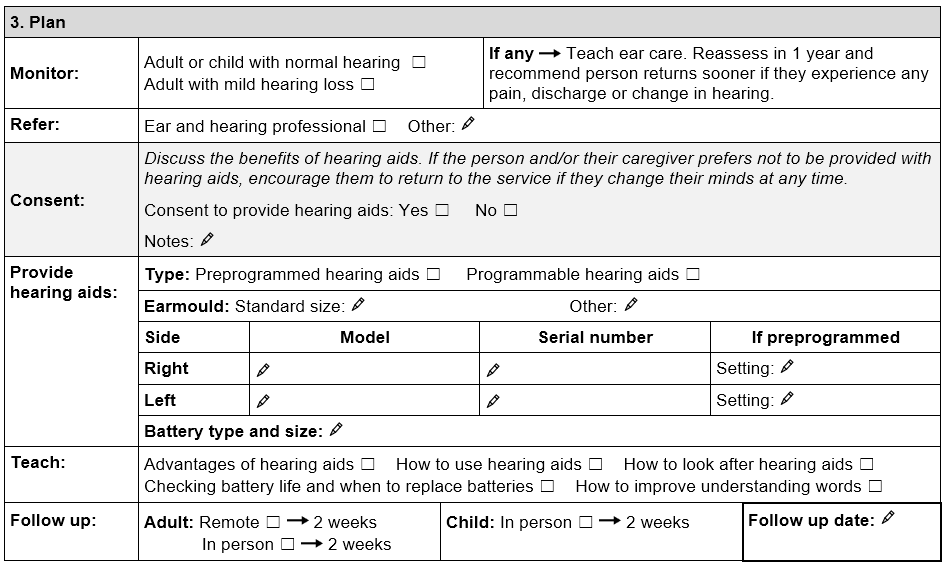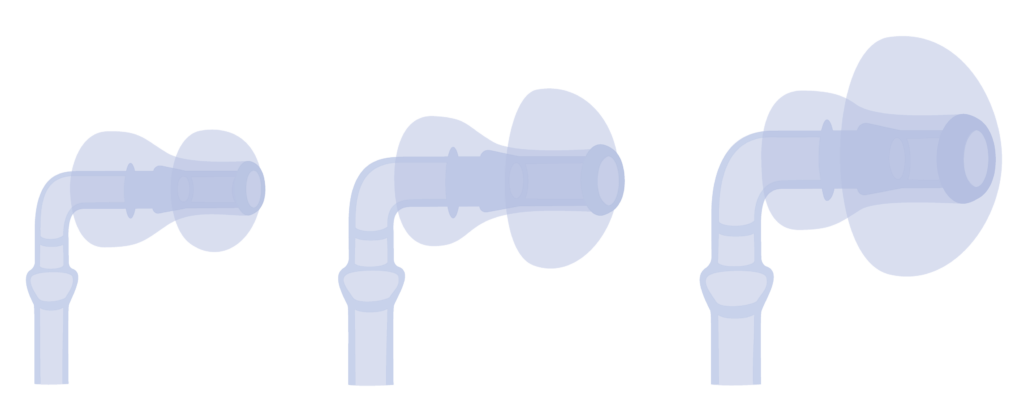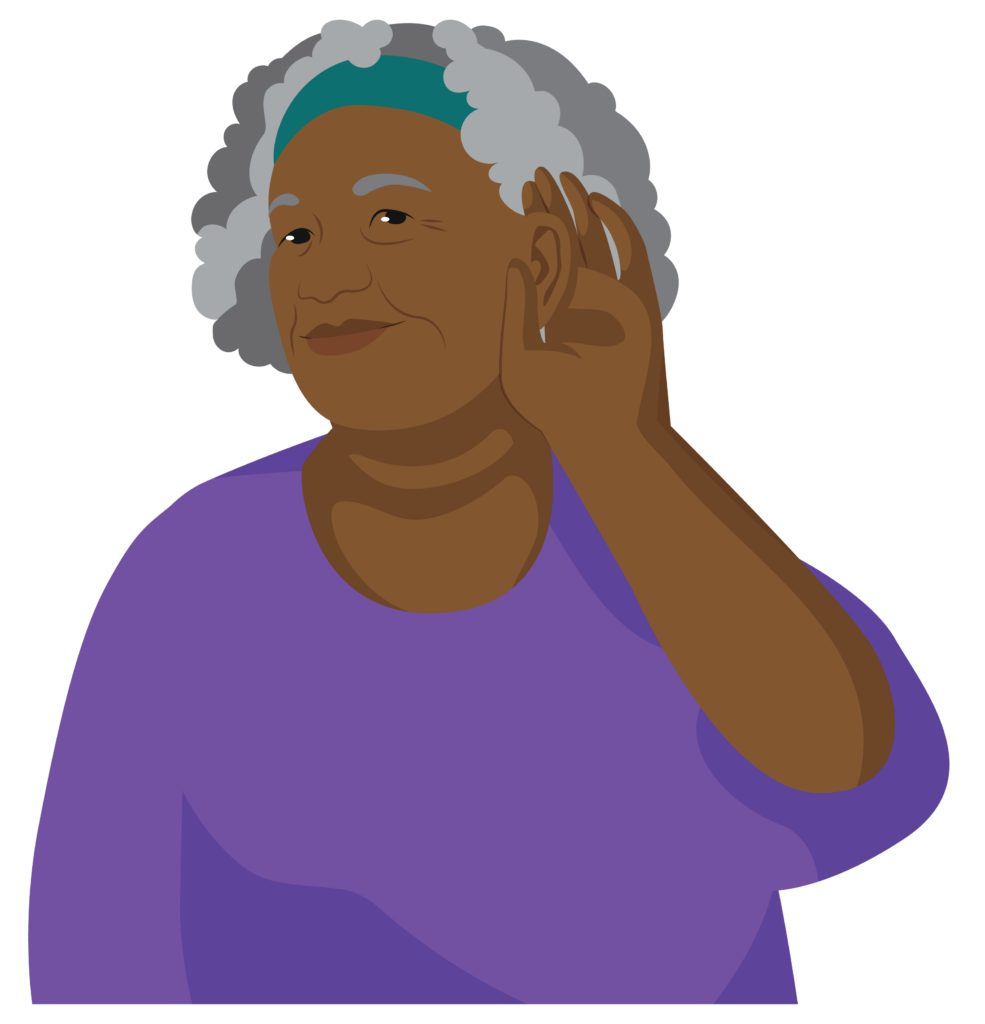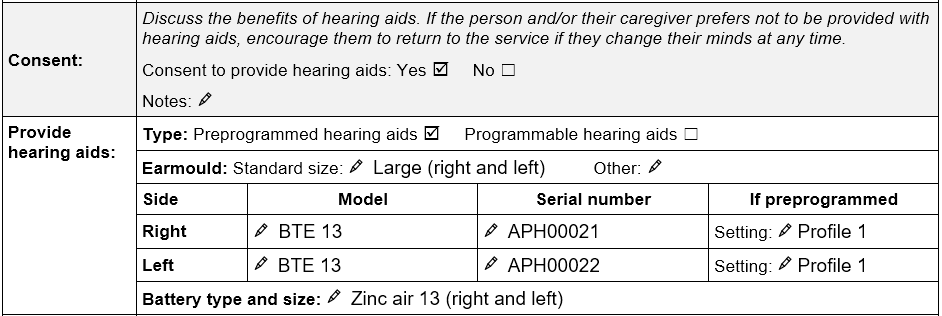After the assessment interview, make a plan with the person. The plan might include:
- نظارت بر شنوایی
- ارجاع دادن
- ارائه سمعک
- Teaching the person how to use their hearing aids safely
- برگزاری جلسات پیگیری با فرد

دستورالعمل
You will learn more about fitting hearing aids, teaching, and follow up later in the module.
نظارت بر شنوایی
You should monitor:
- Adults with normal hearing to mild hearing loss
- Children with normal hearing.
Teach person tips for ear care including:
- Avoid putting anything inside your ear
- از شنا کردن در آب کثیف خودداری کنید
- در محیطهای پر سر و صدا از گوشگیر استفاده کنید.
Plan follow up in one year to retest hearing. Encourage the person to return sooner if they experience ear pain, discharge or a change in hearing.
دستورالعمل
Read more about ear care and tips for healthy ears.
با پدرو آشنا شوید

پدرو ۴۵ ساله است و در یک اداره دولتی کار میکند. او از ویلچر برقی استفاده میکند.
Pedro notices he is not hearing very well when he is on the phone.
He visits his health clinic. The health worker completes an ear health screen. When looking inside his ear with an otoscope they find that Pedro’s ear is blocked with ear wax.
After having his ear wax removed, the health worker does a hearing test. Pedro’s hearing is normal.
The health worker explains to Pedro that he should return in one year to monitor his hearing or book an earlier appointment if he experiences any change in his hearing.
ارجاع
Some people require more specialist assessment by an ear and hearing professional.
برای موارد زیر سمعک تهیه نکنید:
- Adults with profound hearing loss
- کودکان مبتلا به کمشنوایی شدید تا عمیق
- People with more than 15 dB difference between right and left ear.
With their permission refer to an ear and hearing professional.
If you are not confident about the hearing test result, discuss with your mentor and refer to an ear and hearing professional.
نکته
People with some types of severe hearing loss benefit from hearing aids, while others may not. Follow up is important to check how much the person is benefitting. Refer to an ear and hearing professional if needed.
رضایت
Some people will benefit from hearing aids. However, a person may need time to think about whether they want hearing aids.
Explain the potential benefits of hearing aids and offer the opportunity to experience using them before deciding.
If the person prefers not to be provided with hearing aids, encourage them to return to the service if they change their mind at any time.
Record if the person gives consent to provide hearing aids.
ارائه سمعک
First select the type of hearing aid:
- Preprogrammed for adults or
- Programmable for children.
دستورالعمل
Programmable hearing aids are suitable for adults. On TAP, if an adult requires programmable hearing aids refer to ear and hearing professional.
قالب گوش
Record the size of a standard earmould that fits comfortably in the person’s ear.
The earmould should not be:
- Too loose as it will cause feedback (whistling)
- Too tight as it may cause pain.

سمعک
Record details of both hearing aids. Include the model of hearing aid and the serial numbers. This information is important if the hearing aid needs to be repaired.
For preprogrammed hearing aids, record the selected setting. This is useful if the person accidentally changes the setting.
نکته
Check packaging and user manual for serial numbers.
Serial numbers may be found on the body of the hearing aid or in the battery compartment.
باتری
A hearing aid battery needs to be replaced regularly.
Record the type and size of hearing aid battery. Different types and sizes have different coloured labels.

آموزش نحوه استفاده
For people to get the most benefit from hearing aids, explain:
- مزایای سمعک
- نحوه استفاده و مراقبت از سمعک
- نحوه بررسی عمر باتری و زمان تعویض باتریها
- چگونه درک کلمات را بهبود بخشیم.
دستورالعمل
در درس چهارم درباره نحوه استفاده از سمعک بیشتر بیاموزید.
پیگیری
People need time to adjust to using hearing aids. Advice on simple problem solving can help.
It is important to follow up within two weeks to discuss how the person is getting on.
دستورالعمل
Learn more in Lesson five about hearing aid follow up and problem solving.
دستورالعمل
You are now going to practice making a plan.
سوال

ملیکا رو یادته؟
Malicka is 70 years old and a grandmother. She had a hearing test. The results for both her right and left ears show moderately severe hearing loss.
1. What type of hearing aid would you select for Malicka?
یکی را انتخاب کنید.
Preprogrammed is correct!
Malicka is an adult. Start by offering her preprogrammed hearing aids for both ears.
The large earmould fits Malicka’s ears comfortably. You record the details for each hearing aid in the form:

2. Would you recommend monitoring Malicka in one year?
یکی را انتخاب کنید.
پاسخ خیر درست است!
Malicka has moderately severe hearing loss and requires hearing aids. She should have regular follow up instead of yearly monitoring.
3. What would you teach Malicka?
تمام مواردی که قبول دارید را انتخاب کنید.
همه موارد صحیح است!
Malicka is receiving hearing aids for the first time. She needs to know how she will benefit from using hearing aids and how to care for her ears and hearing. It is important to know how to use and look after hearing aids and when to change the battery.
Tips for improving understanding words are useful for Malicka and for friends and family when communicating with her.